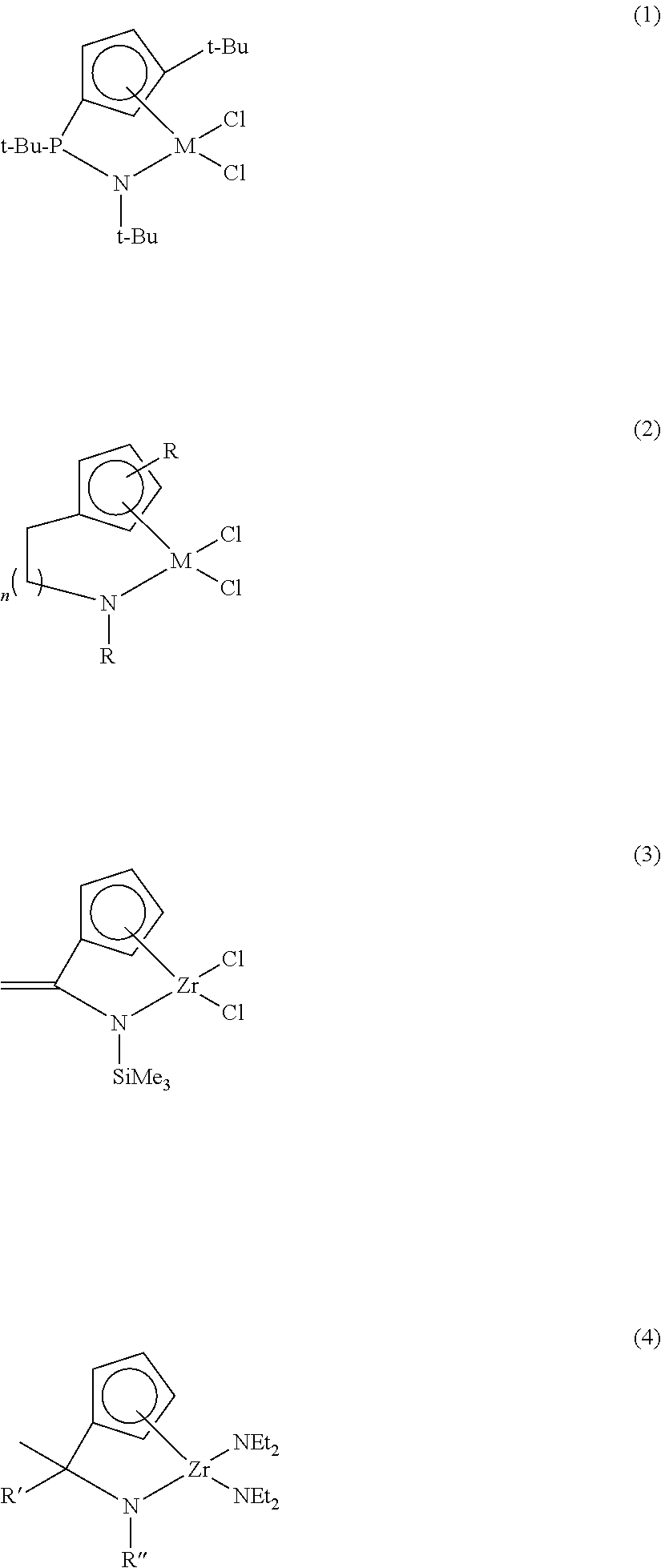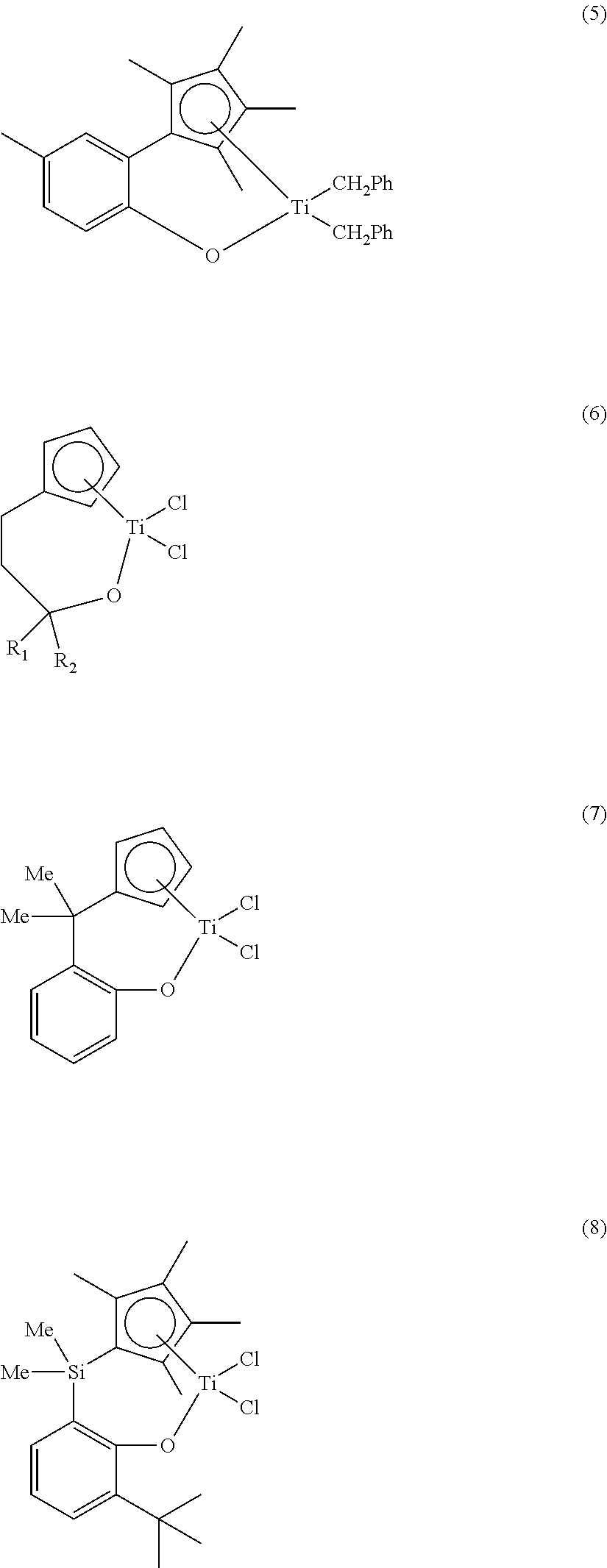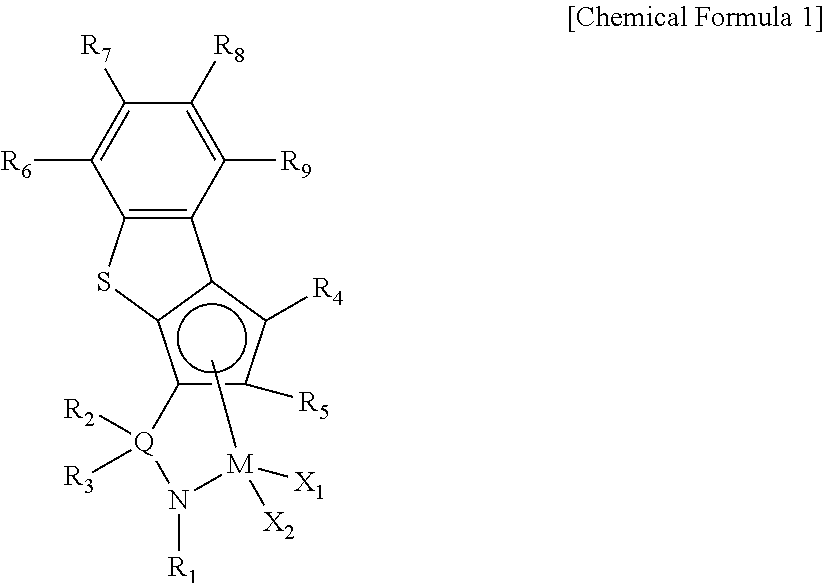Ligand compound, transition metal compound, and catalystic composition including the same
a transition metal and catalystic composition technology, applied in the field of ligand compounds, can solve the problems of small number of catalysts used in commercial factories, and achieve the effects of low density area, high molecular weight and high molecular weigh
- Summary
- Abstract
- Description
- Claims
- Application Information
AI Technical Summary
Benefits of technology
Problems solved by technology
Method used
Image
Examples
example 1
[0168]
[0169]In a 50 ml schlenk flask, the ligand compound of Chemical Formula 2-1 (1.06 g, 3.22 mmol / 1.0 eq) and 16.0 mL (0.2 M) of MTBE were placed, and stirred first. At −40° C., n-BuLi (2.64 ml, 6.60 mmol / 2.05 eq, 2.5 M in THF) was added thereto, and the result was reacted overnight at room temperature. After that, MeMgBr (2.68 ml, 8.05 mmol / 2.5 eq, 3.0 M in diethyl ether) was slowly added dropwise thereto at −40° C., and then TiCl4 (2.68 ml, 3.22 mmol / 1.0 eq, 1.0 M in toluene) was added in order, and the result was reacted overnight at room temperature. After that, the reaction mixture was filtered by passing through Celite using hexane. After the solvent was dried, a brown solid was obtained in a yield of 1.07 g (82%).
[0170]1H-NMR (in CDCl3, 500 MHz):
[0171]7.99 (d, 1H), 7.68 (d, 1H), 7.40 (dd, 1H), 7.30 (dd, 1H), 3.22 (s, 1H), 2.67 (s, 3H), 2.05 (s, 3H), 1.54 (s, 9H), 0.58 (s, 3H), 0.57 (s, 3H), 0.40 (s, 3H), −0.45 (s, 3H).
example 2
[0172]
[0173]In a 10 ml schlenk flask, the ligand compound of Chemical Formula 2-2 (134.0 mg, 0.43 mmol / 1.0 eq) and 2.6 mL (0.2 M) of MTBE were placed and stirred. At −40° C., n-BuLi (0.34 ml, 0.86 mmol / 2.0 eq, 2.5 M in THF) was added thereto, and the result was reacted overnight at room temperature. After that, MeMgBr (0.85 ml, 1.3 mmol / 3.0 eq, 3.0 M in diethyl ether) was slowly added dropwise thereto at −40° C., and then TiCl4 (0.43 ml, 0.43 mmol / 1.0 eq, 1.0 M in toluene) was added in order, and the result was reacted overnight at room temperature. After that, the reaction mixture was filtered by passing through Celite using hexane. After the solvent was dried, a brown solid was obtained in a yield of 60.6 mg (36%).
[0174]1H-NMR (in C6D6, 500 MHz):
[0175]7.80 (d, 1H), 7.39 (d, 1H), 7.17 (dd, 1H), 7.01 (dd, 1H), 5.02 (m, 1H), 2.36 (s, 3H), 1.89 (s, 3H), 1.22 (m, 6H), 0.61 (s, 3H), 0.58 (s, 3H), 0.40 (s, 3H), −0.03 (s, 3H).
example 3
[0176]
[0177]In a 50 ml schlenk flask, the ligand compound of Chemical Formula 2-3 (1.45 g, 4.81 mmol / 1.0 eq) and 25 mL (0.2 M) of MTBE were placed and stirred. At −40° C., n-BuLi (3.94 ml, 9.86 mmol / 2.5 eq, 2.5 M in THF) was added thereto, and the result was reacted overnight at room temperature. After that, MeMgBr (4.0 ml, 12.02 mmol / 2.5 eq, 3.0 M in diethyl ether) was slowly added dropwise thereto at −40° C., and then TiCl4 (4.81 ml, 4.81 mmol / 1.0 eq, 1.0 M in toluene) was added in order, and the result was reacted overnight at room temperature. The reaction was not complete based on an NMR result, and MeLi (3.0 ml, 4.81 mmol / 1.0 eq, 1.6 M in diethyl ether) was slowly added dropwise thereto to complete the reaction. After that, the reaction mixture was filtered by passing through Celite using hexane. After the solvent was dried, a brown solid was obtained in a yield of 1.02 g (56%).
[0178]1H-NMR (in CDCl3, 500 MHz):
[0179]8.03 (d, 1H), 7.68 (d, 1H), 7.42 (dd, 1H), 7.30 (dd, 1H), 4.2...
PUM
| Property | Measurement | Unit |
|---|---|---|
| pressure | aaaaa | aaaaa |
| temperature | aaaaa | aaaaa |
| density | aaaaa | aaaaa |
Abstract
Description
Claims
Application Information
 Login to View More
Login to View More - R&D
- Intellectual Property
- Life Sciences
- Materials
- Tech Scout
- Unparalleled Data Quality
- Higher Quality Content
- 60% Fewer Hallucinations
Browse by: Latest US Patents, China's latest patents, Technical Efficacy Thesaurus, Application Domain, Technology Topic, Popular Technical Reports.
© 2025 PatSnap. All rights reserved.Legal|Privacy policy|Modern Slavery Act Transparency Statement|Sitemap|About US| Contact US: help@patsnap.com



